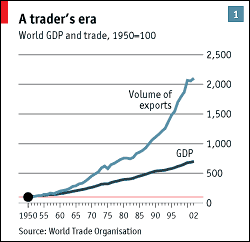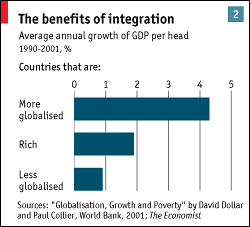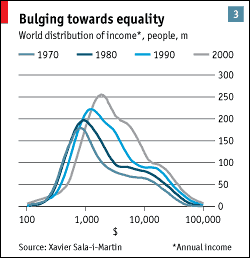|
| ||||||
|
| |
 | |
|
|
THE past half-century can be seen as a long exploration of the power of liberal trade to raise living standards, not only in the rich world but among the poor too. It has also, more recently, been an exploration of people's preference, when given the choice, for democracy. The process is lamentably patchy and far from complete. Still, it has been an extraordinary success which holds great promise for the future.
The story begins with the growth that took place in western Europe, North America, Australasia and Japan once the two great scourges of economic activity—war and trade restrictions—were removed after 1945. These countries were the main signatories of the General Agreement on Tariffs and Trade in 1947 (Japan joined in 1955), which began the process of dismantling trade barriers. That group, subsequently known as “the West”, increased its income per head fourfold in 1950-2001, a growth rate averaging 2.8% a year. Chart 1 shows how world GDP growth, led by the West, came to be associated with even faster growth in world trade.
The rest of the world—communist, socialist, or just plain poor—also grew, but more slowly: at 2.2% a year on average, or a threefold rise in income per head. Thus the gap between “the West and the rest”, as Angus Maddison, an economic historian, described it in an OECD report in 2002 from which these figures are taken, has been widening. It is now especially wide between the richest few countries in the world and the poorest few, which are mainly in Africa; wider, indeed, than ever before. Sceptics about trade use such increases in global inequality as evidence that under liberalism the rich get richer and the poor stay poor. Yet that is wrong.
Such broad figures disguise the underlying trends. These are that countries in Asia have actually been narrowing the gap substantially: there, excluding already-developed Japan, in 1950-2001 income per head increased fivefold. In the early decades, Asian growth could be dismissed as exceptional, given that it was limited mainly to the city states of Hong Kong and Singapore, and two politically anomalous countries, Taiwan and South Korea. But since 1980, not only has growth spread to South-East Asia but it has also accelerated in the world's most populous countries, China and India. Given that Asia as a whole is home to well over half of the world's people, such progress can no longer be dismissed.
The countries that have succeeded in raising living standards rapidly, over long periods, have followed many varieties of economic policy and have lived under many different forms of government. What they have had in common, though, has been a policy of opening their economies to trade and to foreign capital. Not fully, or even nearly so: none, except perhaps tiny Hong Kong, has followed the laisser-faire formula demonised by anti-globalists (which, incidentally, America has not followed either). Nor have they grown by somehow promoting exports and blocking all imports. Rather, they liberalised some markets in order to stimulate competition, internally and from imports; and they ensured that imports of most basic commodities and components faced few barriers, in order to keep prices down for the users of such goods. They adopted liberal trade partially, selectively and mostly gradually. But the important thing was that they adopted it.
|
| |
 | |
|
|
Chart 2 shows the World Bank's depiction of the effects of such policies since 1990, a period during which the move away from closed, centrally planned economies became a rush, following the fall of the Soviet Union in 1991. Countries that have opened their borders in this way have seen their incomes per head grow rapidly—much more rapidly than either the existing rich countries or those that have not globalised, either by choice or through lack of opportunity. There have been failures, most notably in the former Soviet Union, where Russia and its nearest neighbours, Ukraine and Belarus, suffered economic decline in the 1990s even when they did liberalise some markets; and most recently in Argentina where a fixed exchange rate combined with fiscal profligacy led to disaster. But such failures are heavily outweighed by the successes.
The result is that far from rising, global inequality has actually been falling substantially. Not when measured as the gap between the very richest and the very poorest. Nor when measured, as has until recently been the rather odd norm, as the difference between the average incomes of each country, regardless of population (thus counting Chad and China as if they were of equal size). But if it is measured in the way which is normal within countries, as the distribution of individual incomes, it has narrowed considerably. Given the rapid growth in China over the past 20 years, and the less rapid but still healthy growth in India, that observation makes eminent sense: huge chunks of the world's population have been climbing out of poverty. Even so, it is controversial.
Far from rising, global inequality has actually been falling substantially |
Such things are, admittedly, hard to measure. There is no worldwide census of everyone's individual income, so indirect routes must be used to estimate it. But two different studies, using different methods, have now come up with broadly the same conclusion. One, by Xavier Sala-i-Martin of New York's Columbia University for America's National Bureau of Economic Research, is depicted in chart 3: it shows how rising incomes, especially in Asia, are creating what, in world terms, could be described as a huge middle class. As the bulge moves to the right of the chart, so incomes are becoming more equal.
Another study, by an Indian economist named Surjit Bhalla, in a book for the Institute for International Economics called “Imagine There's No Country”, confirmed those findings as well as the consequent drop in world poverty. Measured by the benchmark favoured by the World Bank of income of $2 a day or less, adjusted to cater for differences in purchasing power, the proportion of the world's population in poverty dropped from 56% in 1980 to 23% in 2000, on Mr Bhalla's calculations. Thanks to population growth, the absolute number of people in that category remains large: more than 1.1 billion. But that is still far fewer than in 1990 (1.7 billion) and 1980 (1.9 billion). Before 1980, the absolute numbers were rising. That date roughly coincides with the spread of trade and internal-market liberalisation to many poor countries.
|
| |
 | |
|
|
The truth about market liberalisation and economic growth is not that it increases inequality, nor that it hurts the poor: just the opposite. Rather, the truth is that some large parts of the poor world are pulling themselves out of poverty while others are not. Those poorer parts include some countries in Asia, including Pakistan and Central Asia, and some in Latin America as well as most of the Middle East, where liberalisation has scarcely been attempted and revenues from oil have lately declined. Most notably, though, they include more or less a whole continent, namely Africa. There, incomes have stagnated or even declined, and life expectancies are falling too, thanks to AIDS and other plagues. Home to 13% of the world's population, the continent accounts for merely 3% of world GDP. The lack of progress in Africa, not the supposed evils of globalisation, is where the most difficult problem of economic development lies.
Alongside this successful growth in economic liberty, there has also been an impressive expansion of political and civil freedoms. Since 1980, according to the 2002 United Nations Human Development Report (UNHDR), 81 countries have taken “significant” steps towards democracy, with 33 military regimes replaced by civilian governments. Of the world's nearly 200 countries, 140 now hold multi-party elections. That may not make them fully democratic, but 82 of them are, and those are home to 57% of the world's population. Especially pleasing to an independent organ such as The Economist is the fact that, according to the UNHDR, 125 countries, with 62% of the world's population, now have a free or partly free press. The spread of daily newspapers in developing countries has risen to 60 copies per 1,000 people, from 29 in 1970-96, and the number of televisions has increased 16-fold.
Recently, it has become fashionable to play down that progress by pointing out that many of the new democracies have not gone beyond elections to build the other, essential, protections for liberty: an independent judiciary, equality before a well-enforced rule of law, and constitutional limits on the abuse of political power. In Zimbabwe, an elected president, Robert Mugabe, has ruined the country, sponsored violence and rigged elections. Constitutions have been violated by elected politicians in Peru and Russia, and judiciaries manipulated. Venezuela's elected president, Hugo Chavez, essentially wrote his own constitution, which he hands out to visitors as a little blue book reminiscent of Mao Zedong's red one.
In sub-Saharan Africa, according to “The Future of Freedom”, a new book by Fareed Zakaria that wrings its hands about “illiberal democracy”, 42 out of 48 countries have held multi-party elections since 1990, but most have simply allowed a rotation of plundering governments. A few democracies have even collapsed: Pakistan's elected government was overturned in a coup in 1999 by General (now self-appointed President) Pervez Musharraf.
Such worries are perfectly fair. Much more progress is needed. It would be wrong to celebrate the mere holding of elections if other, arguably even more important, protections for liberty are not present or likely soon to be created. Some democracies, including long-standing ones such as Malaysia and Singapore, essentially have semi-authoritarian regimes. Yet such legitimate concerns should not be allowed to detract from the basic progress that has occurred: in the past 20 years the share of the world's population living in proper democracies has risen from about a third to just over half. Freedom House, a Washington-based think-tank, this year rated 89 countries as being “free societies”, up from 75 in 1993, and a further 55 as “partly free”. Liberty has had a period of tremendous advance on all fronts.
In the past 20 years the share of the world's population living in proper democracies has risen from about a third to just over half |
In the short term, there is cause for optimism that this advance will continue. Despite economic crises in East Asia, Russia and Latin America during the past six years, developing countries still seem to want to liberalise their economies. China has recently joined the World Trade Organisation, bringing the total membership to 146 countries, and Russia is in the queue for membership, along with 25 others. After shrinking slightly in 2001, the volume of world trade started to grow again in 2002, albeit weakly. Efforts have begun to try to implant democracy in Afghanistan and Iraq. Argentina has endured an economic collapse to match the Great Depression of the 1930s, yet has emerged with its democracy intact.
For all the anti-globalists' cries on their behalf, few of the world's poorer countries show signs of wanting to retreat from liberalism: their question, rather, is whether to extend it rapidly or gradually, and whether they have the domestic governmental institutions to be able to cope with it. Though it does little to promote democracy, China is proving a spur to economic liberalisation in other developing countries: fear that its growth will steal their markets or investment is prompting others to copy its reforms and to adopt international trade rules by joining the WTO. The real doubts are in the pioneers of globalisation, the rich countries.
Business is under attack, even in the homeland of free enterprise, the United States, whether from politicians, single-issue lobby groups or, most dangerously of all, from lawyers. Having made pots of cash from tobacco firms, they are turning their attention to Wall Street and to drug companies. Anti-capitalist demonstrations on May 1st in cities around the world attracted sizeable crowds. Stockmarkets remain weak, despite a quick end to the war in Iraq and a 30% fall in oil prices. So do many economies, especially the biggest and richest ones in western Europe, Japan and the United States.
There is always anxiety that the good times may never return. Yet they always do |
Plus ça change, once again? Wherever democracy allows a crowd to gather, there will always be some who resent the selfishness inherent in the profit motive, or who stand to lose from the change that economic and technological progress or the evolution of tastes may bring, or who simply like a good march and love to yell abuse at the high and mighty. With the economic, social and even environmental failure of communism and its milder comrade, socialism, still fresh in the memory, there is little chance that any alternative to a capitalist economy could soon garner widespread support. And whenever economies approach the bottom of their inevitable cycles, there is always anxiety that the good times may never return. Yet they always do.
There are, though, some stronger reasons to worry. One, admittedly, is generic to all bad times: the fact that it is when unemployment is rising, or incomes are falling, or prospects seem dim, or threats of war and terrorism spread fear and anger, that politicians come under the greatest pressure—and temptation—to close borders or to slap controls on freedoms of all kinds, whether civil or commercial. They may wish to curry favour with domestic lobbies or merely to look as if they are doing something.
Another reason, however, is peculiar to today and risks greatly amplifying the generic one. It is that the economic and financial-market boom of the 1990s was so extreme that its bust is also producing extreme results: a pile of corporate scandals, resentment at an extraordinary widening of inequalities of income and wealth within the rich countries, a ghastly hole in the retirement funds of millions of ordinary people and, most crucially of all, a gathering disillusion about the ability of democratic institutions to hold culprits accountable for their sins.
Such results can be seen, in some measure, right across the developed world. But they are at their most noticeable in the United States, for that is where the 1990s boom, along with its extremes of misbehaviour, went the furthest. In the title of a feisty and well-researched book by a commentator and political activist, Arianna Huffington, in America in recent years there were “Pigs at the Trough”, extracting gigantic executive salaries and perks, faking corporate accounts, manipulating equity offerings and granting each other vast piles of share options, among other abuses. More outrageously still, many of those benefiting from this flow of cash managed successfully to lobby Congress and the White House to reject reforms that could have stemmed some of the abuse.
When such excesses have occurred in the past, there has been a political backlash to exploit the popular anger, as under the presidencies of Teddy Roosevelt and Woodrow Wilson in the 1900s. That remains a strong possibility, even though the popularity of the famously pro-business President George Bush is running high, thanks to the wars on terror and Saddam Hussein. The danger is often expressed as one of an over-reaction to the excesses, of an excessive bout of regulation on business. That danger exists; but the worst possibility is that anger at capitalist abuses will tip the balance in domestic politics towards protectionism, as a misguided way to help the weak and vulnerable, and to pander to suspicion of markets and business. If it does, remember to blame those pigs and their love of the trough.
| Copyright © 2003 The Economist Newspaper and The
Economist Group. All rights reserved. |